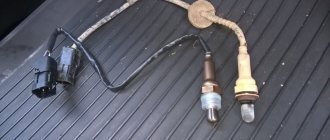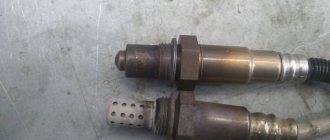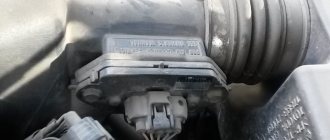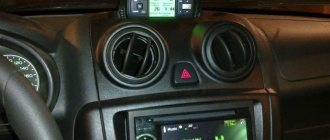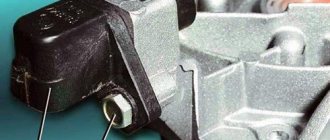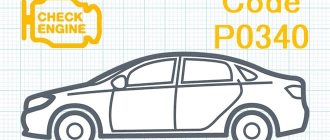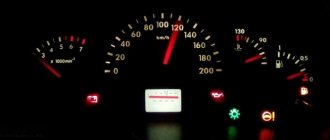What does P0030 mean?
Trouble code P0030 is a general trouble code that indicates that the engine control module (ECM) has detected a malfunction in the oxygen sensor 1 (bank 1) heater circuit. The vehicle's ECM uses an oxygen sensor to monitor the oxygen content of the vehicle's exhaust gases. The ECM uses the signal received from the oxygen sensor to regulate the fuel/air mixture ratio of the engine. The most optimal ratio of air and fuel in the mixture supplied to the engine cylinders is 14.7:1. It is this ratio that is necessary to achieve maximum engine power and optimal fuel consumption.
The oxygen sensor heater is used to heat the internal components of the oxygen sensor to provide faster feedback to the vehicle's ECM. This is necessary to reduce emissions of harmful substances from the vehicle's exhaust gases when starting the engine, especially if the engine is started in a cold state.
What does P0301 mean?
P0301 (and other P030X codes such as P0302, P0303, etc.) are simpler than you might expect. Because the ECU has already determined which cylinder has the problem, saving you the diagnostic headache.
The last digit of the P030X code indicates the number of the misfired cylinder. P0302 is a misfire on cylinder 2, P0303 is on cylinder 3, and so on.
The P0300 code indicates a random misfire. This means that several cylinders are misfiring randomly. Codes P0300 through P0308 are called misfire codes.
If you have one of these errors, you need to fix the problem as quickly as possible. If you drive your vehicle in this condition, you will damage the catalytic converter.
How does a mechanic diagnose a P0030 code?
First, the mechanic reads all the stored data and error codes using an OBD-II scanner. He will then clear the error codes from the computer's memory and test drive the vehicle to see if P0030 appears again. If the error code appears again, the mechanic will visually inspect the heated oxygen sensor for damage, as well as check the ground and measure the voltage at the sensor.
The mechanic will then carefully check any associated electrical wires that may have been damaged due to excessive heat due to high exhaust temperatures.
Diagnosis and problem solving
Trouble P0030 can only be caused by the oxygen sensor heater circuit or the oxygen sensor itself. Diagnostics usually begins with checking the sensor wiring. Typically the heated oxygen sensor comes with four wires.
Two wires go directly to the heater circuit, and the other two are for powering and grounding the sensor. You may need a wiring diagram for your car. To be sure you are testing the correct set of wires.
Wiring check
Test the heater circuit using a digital multimeter or volt-ohmmeter. Consult your vehicle's wiring diagram to determine the exact pinout of the ground connector.
The reading should be close to the battery voltage. If this is not the case, then there is most likely a problem with the sensor's power supply.
It is also necessary to check the grounding. To do this, you need to connect the positive terminal of the battery to the red wire of the multimeter. And the black wire to ground to check the grounding of the circuit. The result should be 12V, if not then this indicates a grounding problem at the sensor.
Sensor check
If the power and ground are ok, then the next option is to check the sensor heating element. To determine if it has an open circuit or high resistance.
Set the volt-ohm meter to Ohm scale, check the resistance of the heater circuit using the electrical diagram as a reference.
Make sure you have disconnected the O₂ sensor. The heater circuit inside the sensor should have little resistance. Exceeding the limit value indicates a break in the heating part. Therefore, the oxygen sensor will have to be replaced.
How serious is P0030?
When a P0030 error occurs, the Check Engine light on your vehicle's dashboard will illuminate, indicating a problem. Failure of the heated oxygen sensor may cause the vehicle's ECM to not be able to properly regulate the fuel/air mixture in the engine. The vehicle's engine may run erratically. It may also increase fuel consumption and damage other vehicle components. If this code is detected, it is recommended that you contact a qualified technician as soon as possible to diagnose and resolve the error.
Often, if the Check Engine Light comes on immediately after starting the engine, the OBD-II system can be reset and the vehicle will continue to operate normally.
Rare cases of error p0300
On some vehicles of the VAZ family with an electronic on-board computer of the M74 series, errors p0300, p0301, p0302 may appear due to problems in the fuse connector. The connector body itself may appear completely sealed and show no external deformation when its contents fail. It is necessary to replace the connector with a new one to eliminate errors.
Thus, the appearance of error code p0300 does not always indicate serious problems in the car’s ignition system. In each specific case, it is necessary to consider all possible options for the occurrence of an error. As stated above, engine misfire is considered one of the most serious problems, so it is necessary to quickly take action to accurately diagnose and eliminate the problem.
What repairs can fix the P0030 code?
To resolve the P0030 error you may need to:
- Clearing error codes from the ECM and test driving the vehicle to see if the P0030 code appears again
- Heated Oxygen Sensor 1 (Bank 1) Replacement
- Repair or replace electrical wires or connector for heated oxygen sensor 1 (bank 1)
- Replacing the fuse in the oxygen sensor 1 heater circuit (bank 1)
- In rare cases, replacing the engine control module (ECM)
Algorithm for checking elements to eliminate error P0300
Since there are many possible causes for error P0300, it is necessary to adhere to a certain troubleshooting algorithm. Here is a sequence of actions to quickly detect the cause of misfires:
If the problem cannot be identified, the next step is to check the spark plugs. Twist them and inspect for oil deposits or damage to the electrode. Also make sure that the spark plug has the correct gap;
The above are the basic steps that most often help to find the cause of the P0300 error code. When checking the above elements, pay attention to their condition - the presence of soot, traces of mechanical damage, and so on.
Other possible causes of the P0300 error must be determined depending on what other errors the scanner indicates during diagnosis. That is, if the oxygen sensor fails, then in addition to P0300, error P0134 or P0130 may occur. Try eliminating other errors that are diagnosed together with P0300, perhaps this will immediately eliminate it too.
( 413 votes, average: 4.49 out of 5)
Related Posts
Error P0326 - knock sensor signal is out of range
Error P0100 - problems in the mass air flow sensor (MAF) circuit
Additional comments for troubleshooting P0030
Many high mileage vehicles (usually over 150,000 kilometers) have short-term problems with sensors, which usually occur when the engine is started or the transmission is subjected to prolonged stress. Often, if the Check Engine Light comes on but the vehicle continues to operate normally, the OBD-II system can be reset and the problem will be resolved. This is why it is important to check for an error code using a scanner and clear the code from the computer's memory before performing any repair work.
P0300 - misfire error. Causes, consequences, elimination
Almost every car owner who has some problems during the operation of his car, throughout the entire time, independently eliminates minor breakdowns, or makes the necessary replacements of any parts. But, unfortunately, sometimes the help of a specialist from a car service is necessary, since car enthusiasts do not have enough skills, experience or knowledge in any of the areas regarding the repair of their vehicle. But don’t worry, because our instructions will help you figure it out and do everything yourself.
The error code P0300 indicates an incorrect ignition order, which means random multiple misfires in the cylinders; in English, the diagnostic device will display: “Random cylinder misfire detection system.” If gaps are found in a certain cylinder, then the outermost number P030x will change from 1 to 4 and so on up to 6, or maybe up to 12, it all depends on which specific “pot” the transmission is in. Therefore, error p0300 is the original one from such errors as P0301, P0302, P0303, P0304. They often happen due to the fact that there is no spark, the supply of the fuel mixture is disrupted, or there are problems with the release of exhaust gases.
We will talk in more detail about all the probable causes of misfire and errors p0301, p0302, p0303, p0304, what the consequences are and how to eliminate them.
What causes the P0300 code to appear?
If a misfire occurs in the engine, the level of intoxication of exhaust gases in the exhaust pipe increases, which also leads to an increase in degrees in the catalyst device, because of this it is damaged (the cells will melt, since the degrees are more than 800). On a few cars, to reduce the burnout of the fuel mixture in the catalyst and, of course, the level of toxicity, the ECM detects the frequency of misfires using a crankshaft sensor, a camshaft sensor and, in addition, registers error p0300, indicating this with a check-in lamp. In addition, the unit is able to turn off the injectors of a specific cylinder where leakage was found. It should be noted that drivers of cars such as Lacheti, Matiz, Priora and other VAZs with an injector, as well as Opel, Nissan, and Kia models, are often interested in the appearance of this error.
When does error code P0300 appear?
It is worth noting that the P0300 error code is recorded by the controlled unit only when some cylinders have misfires at the same time, since a misfire in one of them can only be recorded after 2 repetitions at once; the frequency of rotational movements of the CV is important here. At idle, the error will be entered into memory after three and a half minutes of engine activity, and at revs of more than two thousand km - a little more than 1 minute. The extreme rate of DTC in the ECM memory is more than 3.25 percent, missed flashes per thousand revolutions. When misfires are found only in a specific cylinder, then it is not error p0300 that is generated, but another one, with the order number of the combustion chamber of the internal combustion engine.
Method for determining cylinder misfires
It will be easy to find out that the yellow check lamp is on due to a disturbed flammability order, since, due to the ignition being started, the engine begins to “sausage” at low speeds, there are jerks and jerks during acceleration, and there is still no traction, and the consumption of the fuel mixture increases.
Error p0300, p0301, p0302, p0303 and p0304 causes of occurrence
Unfortunately, the diagnostic device is not able to find a specific cause of the malfunction and with regard to misfire in the engine cylinder, but more possible breakdowns occur in 2 cases - either there is no fuel, or there is nothing to burn it with. But, do not rush to experience the joy of quickly finding the cause of error p0300, as this may also become:
Cylinder misfires. Method for diagnosing the cause.
The main causes of error P0300
3. In the intake and exhaust mechanism:
4. In the controllability electronics system:
Not a common problem of multiple misfires lies in the ignition system
Tips for checking and troubleshooting
First, let's check the ignition wires and ignition coils (module) if the ignition misfires. Often they come with knocked out insulation, torn or with an oily surface. We measure the wiring using a multimeter (good resistance is about 4-10 kOhm), in resistance mode. To check individual ignition coils, you just need to swap places with the exact working cylinder and clear the error again. If the code designation has changed to the license plate of a different cylinder, the coil turns out to be broken. With the ignition module, everything is not so simple; you need to check it with a tester.
All elements of the ignition mechanism must be checked with great care for signs of wear or damage.
Afterwards, we go to the spark plugs - the electrode is damaged, the gap is incorrect or there is oil deposits, a failure occurs or the spark plugs are unstable.
The spark plug insulation should be white, without any yellow marks from spark holes. Having taken out the spark plug to inspect it, we measure the compression in the cylinder. If it is low or absent, this will lead to incomplete compression and will also create problems with the mixture ignition.
Fuel injectors are clogged , which leads to interruptions in the supply of the fuel mixture to the combustion chamber, but, unfortunately, without a stand it will not be possible to quickly check. In this case, we can only recommend adding a fuel mixture with a high octane number and driving the car a little at higher rpm (4-5 thousand rpm).
If the fuel filter has not been changed for a long time or bad gasoline has been used, this often leads to improper operation of the injector. Therefore, you need to remember when you changed the filter and where you filled the fuel mixture.
EGR valve is stuck or there is a leak through the intake manifold gasket - something that also often becomes the reason for detecting random misfires. It is unlikely that you will be able to determine this on your own, so when diagnosing with a computer, you need to pay attention to the indicator of long-term correction of the fuel mixture. It will indicate how much the ECU will compensate for the imbalance in the air/fuel mixture. If this parameter in a certain cylinder differs by ten percent, then this indicates a vacuum leakage and air mass being sucked in.
A good adjustment will not exceed one to three percent or one side. It also happens, but rarely, that the cause of a disrupted ignition order is disrupted gas distribution phases or disrupted exhaust gas outlets; they are controlled by the controlled unit and, in addition to the P030X code designation, there are other errors that relate to the catalyst device, oxygen sensor, camshafts.
See all photo news >>
Troubleshooting P0300
- Replace faulty spark plugs.
- Check and repair broken wires.
- Replace the faulty ignition coil.
- Replace or repair the oxygen sensor.
- Inspect the fuel injectors.
- Replace the catalytic converter.
- Replace the faulty head gasket.
- Eliminate air leaks.
- Diagnostics and repair of a faulty engine control unit.
Causes of P0300
Trouble code P0300 is caused by many things. Here are some of them.
- Worn spark plugs.
- Faulty wires.
- Ignition coil malfunction.
- Oxygen sensor malfunction.
- Malfunction of fuel injectors
- Burnt out exhaust valve.
- Faulty catalytic converter.
- The throttle position sensor is faulty.
- Faulty engine control module (PCM/ECM).
- Leak in the cylinder head gasket.
- Intake leakage.
How to replace a spark plug?
Replacing the spark plug is a simple task and you can do it at home. Before changing spark plugs, make sure the engine temperature is low.
Step 1: Open the hood and locate the spark plug
Open the hood and you will see several wires running in the engine compartment. The spark plugs are located in the engine at the end of these wires.
Step 2: Pull the wire
Pull the wire and you will see the spark plug installed.
Step 3: Remove the candle
Insert the spark plug wrench and turn to loosen the spark plug. Remove the old spark plug and note its condition.
Step 4. Install a new spark plug
Using the same spark plug wrench, install the new spark plug and tighten it correctly. Then connect the wire as it was before. All is ready.
Error codes P0030, P0031, P0032, P0036, P0037, P0038. VAZ and methods for their elimination.
Error codes P0030, P0031, P0032, P0036, P0037, P0038. VAZ and methods for their elimination.
Error 0030 - open circuit of the oxygen sensor heater control circuit to the converter.
The error is stored in the ECU memory under the following conditions:
- Engine running
- The ECU self-diagnosis system has determined that there is no load in the circuit.
- Two drive cycles have passed since the malfunction occurred.
- We connect the scanner, start the engine, check for errors in the memory.
If an error is present, then turn off the engine, disconnect the wiring block from the UDC, turn on the ignition and use a multimeter or tester to check the presence of voltage at terminal “B” of the wiring block.
If there is no error, we check the integrity of the electrical circuits, the absence of damage, the correct connection of the pads, the reliability of the contact connections, and the integrity of the seals.
- If there is no voltage at terminal “B” of the wiring block, the heater power supply circuit is broken. Restore the chain.
- If there is voltage at terminal “D” of the wiring block, then if it is less than 1V, then the heater control circuit is broken or the controller is faulty. And if the voltage is more than 1V, we measure the resistance between contacts “B” and “D” of the UDC.
- If the resistance is more than 1KOhm, then the sensor itself is faulty, if less than 1KOhm, then the ECU is faulty.
The ECU is quite an expensive unit, so before deciding to replace it, it is advisable to use a replacement one. And only after making sure that the ECU is to blame, replace it.
Error 0031 - short to ground in the control circuit of the oxygen sensor heater to the converter.
The error is stored in the ECU memory under the following conditions:
- Engine running
- The ECU self-diagnosis system has detected a short to ground at the output
- Two drive cycles have passed since the malfunction occurred.
- We connect the scanner, start the engine, check for errors in the memory.
- If an error is present, then turn off the engine, disconnect the wiring block from the controller, and check the resistance between contact “48” of the block and ground with a multimeter.
- If there is no error, we check the integrity of the electrical circuits, the absence of damage, the correct connection of the pads, the reliability of the contact connections, and the integrity of the seals.
- If the resistance is less than 1 Ohm, then the control circuit is shorted to ground. Eliminate short circuit..
- If the resistance is more than 1 ohm, then the ECU is faulty.
The ECU is quite an expensive unit, so before deciding to replace it, it is advisable to use a replacement one. And only after making sure that the ECU is to blame, replace it.
Error 0032 - short circuit to the on-board network in the control circuit of the oxygen sensor heater to the converter.
The error is stored in the ECU memory under the following conditions:
- Engine running
- The self-diagnosis system of the ECU detected a short circuit to the on-board network at the output.
- Two drive cycles have passed since the malfunction occurred. A possible reason for error 032 is the installation of a different type of DC.
- We connect the scanner, start the engine, check for errors in the memory.
- If the error is present, then turn off the engine, unplug the wiring block from the UDC, turn on the ignition and use a multimeter or probe to check the presence of voltage at terminal “D” of the wiring block.
- If there is no error, we check the integrity of the electrical circuits, the absence of damage, the correct connection of the pads, the reliability of the contact connections, and the integrity of the seals.
- If there is no voltage at terminal “D” of the wiring block, use a multimeter to check the resistance between contacts “B” and “D” of the UDC.
- If there is voltage at terminal “D” of the wiring block, then the control circuit is shorted to the power source or the controller is faulty.
- If the resistance is more than 7 Ohms, then the controller is faulty, if less than 7 Ohms, then the ECU is faulty.
The ECU is quite an expensive unit, so before deciding to replace it, it is advisable to use a replacement one. And only after making sure that the ECU is to blame, replace it.
Error 0036 - open circuit of the oxygen sensor heater control circuit after the converter.
The error is stored in the ECU memory under the following conditions:
- Engine running
- The ECU self-diagnosis system has determined that there is no load in the circuit.
- Two drive cycles have passed since the malfunction occurred.
- We connect the scanner, start the engine, check for errors in the memory.
- If the error is present, then turn off the engine, disconnect the wiring block from the DDK, turn on the ignition and use a multimeter or tester to check the presence of voltage at terminal “B” of the wiring block.
- If there is no error, we check the integrity of the electrical circuits, the absence of damage, the correct connection of the pads, the reliability of the contact connections, and the integrity of the seals.
- If there is no voltage at terminal “B” of the wiring block, the heater power supply circuit is broken. Restore the chain.
- If there is voltage at terminal “B” of the wiring block, then connect a multimeter between contact “D” of the block and ground. If it is less than 1V, then the heater control circuit is broken or the controller is faulty. And if the voltage is more than 1V, we measure the resistance between contacts “B” and “D” of the UDC.
- If the resistance is more than 1KOhm, then the sensor itself is faulty, if less than 1KOhm, then the ECU is faulty.

